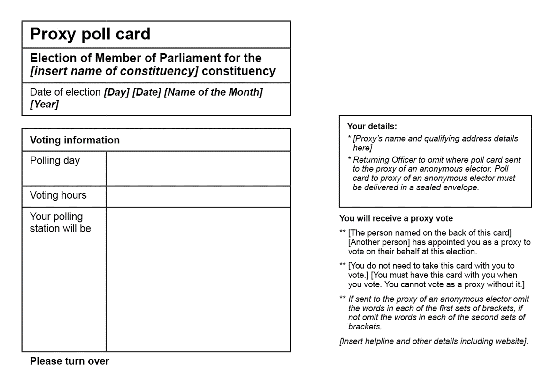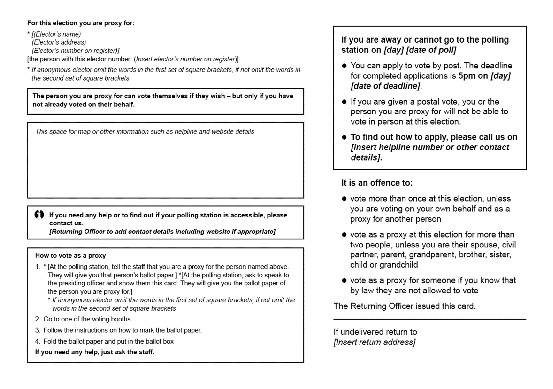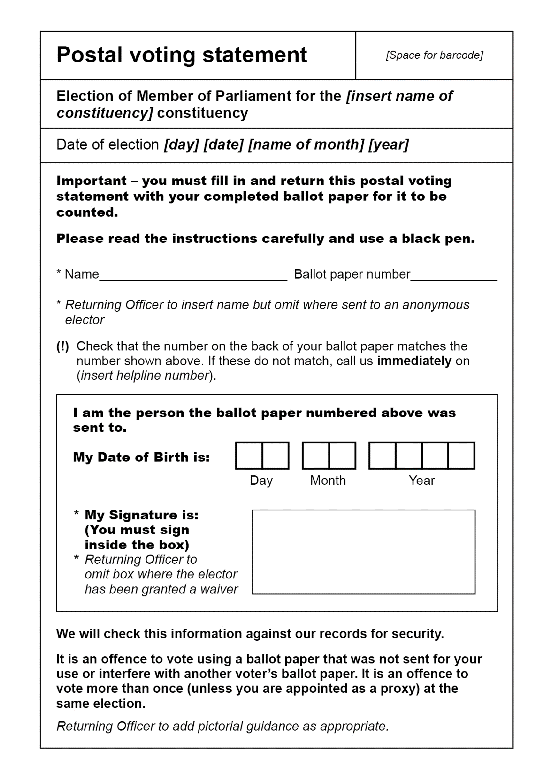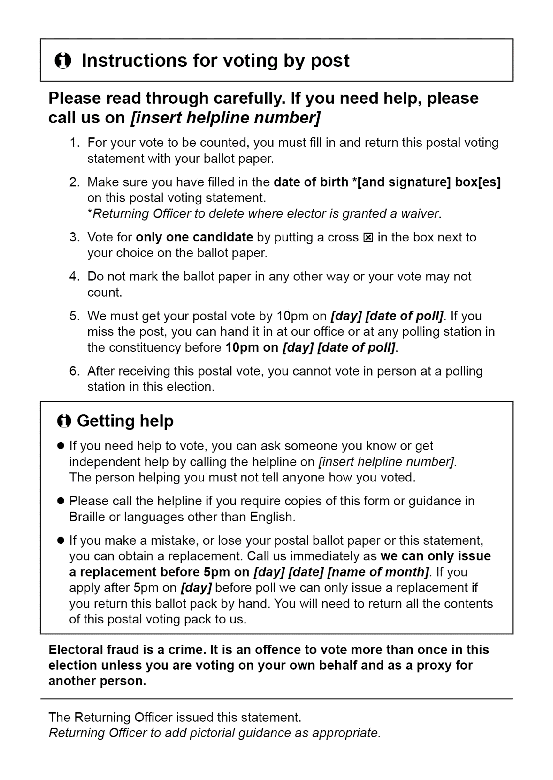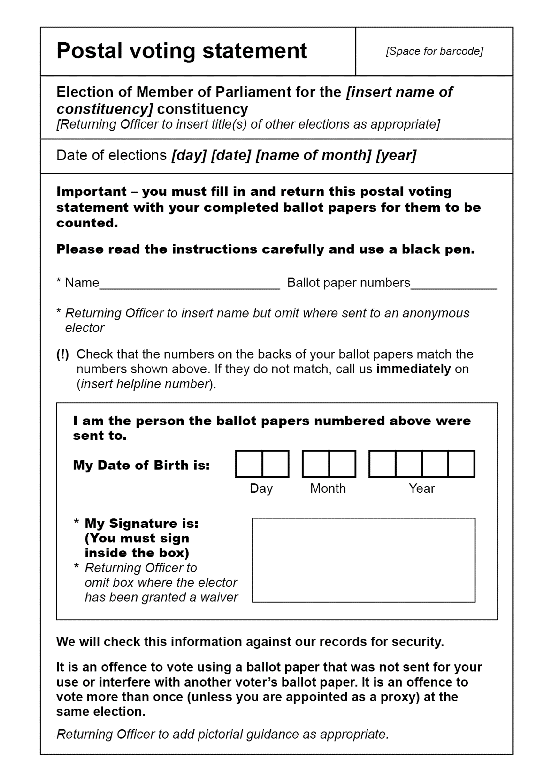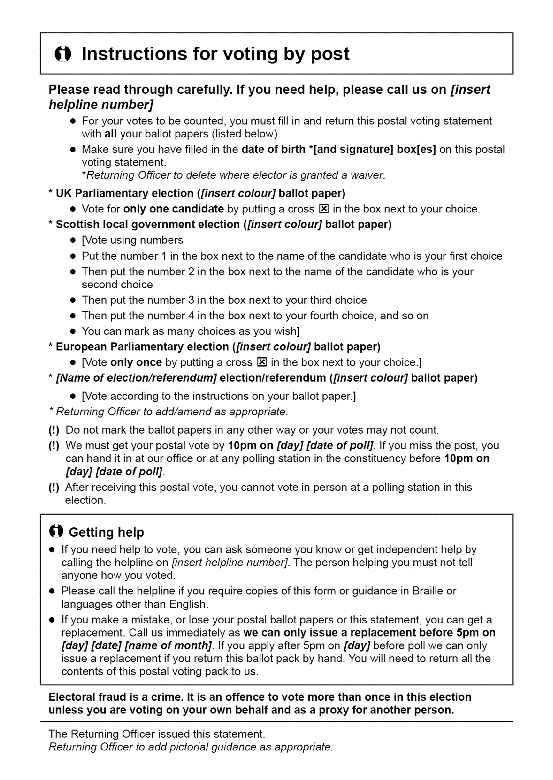SCHEDULE 1ENABLING POWERS
These Regulations are made under the following powers:
(a)
(b)
(c)
(d)
(e)
SCHEDULE 2REVOCATIONS
1 Regulations revoked | 2 References | 3 Extent of revocation |
|---|---|---|
1. The Representation of the People (Scotland) Regulations 2001 | Regulation 20. | |
2. The Representation of the People (Scotland ) Regulations 2001 | Regulations 81(5)(b), 85 and 85B. | |
3. The Representation of the People (Scotland) (Amendment) Regulations 2002 | Regulation 13. | |
4. The Representation of the People (Form of Canvass) (Scotland) Regulations 2006 | The whole of the regulations. | |
5. The Representation of the People (Scotland) (Amendment) Regulations 2007 | Regulation 35(3), (4), (5) and (6). Regulations 54(b)(ii) and 55. In Schedule 2, Forms A, A1, B, B1, G, H and J. | |
6. The Representation of the People (Scotland) (Amendment) Regulations 2008 | Regulation 9. Regulation 10, insofar as it inserts regulation 85B into S.I. 2001/497. Regulation 12(1). In the Schedule, Forms A1, B1, G, H and J. |
SCHEDULE 3Form of words about the two versions of the register
Short version of the form of words
There are two registers. Why?
Using information received from the public, registration officers keep two registers – the electoral register and the open register (also known as the edited register).
The electoral register lists the names and addresses of everyone who is registered to vote in public elections. The register is used for electoral purposes, such as making sure only eligible people can vote. It is also used for other limited purposes specified in law, such as:
detecting crime (e.g. fraud)
calling people for jury service
checking credit applications.
The open register is an extract of the electoral register, but is not used for elections. It can be bought by any person, company or organisation. For example, it is used by businesses and charities to confirm name and address details.
Your name and address will be included in the open register unless you ask for them to be removed. Removing your details from the open register does not affect your right to vote.
Long version of the form of words
There are two registers. Why?
Using information received from the public, registration officers keep two registers – the electoral register and the open register (also known as the edited register).
The electoral register lists the names and addresses of everyone who is registered to vote in public elections.
The register is used for electoral purposes – such as making sure only eligible people can vote – and for other limited purposes specified in law. The personal data in the register must always be processed in line with data-protection legislation.
Who uses the electoral register?
Election staff, political parties, candidates and holders of elected office use the register for electoral purposes.
Your local council and the British Library hold copies that anyone may look at under supervision. A copy is also held by the Electoral Commission, the Boundary Commissions (which set constituency boundaries for most elections) and the Office for National Statistics.
The council can use the register for duties relating to security, enforcing the law and preventing crime. The police and the security services can also use it for law enforcement.
The register is used when calling people for jury service.
Government departments may buy the register from local registration officers and use it to help prevent and detect crime. They can also use it to safeguard national security by checking the background of job applicants and employees.
Credit reference agencies can buy the register. They help other organisations to check the names and addresses of people applying for credit. They also use it to carry out identity checks when trying to prevent and detect money laundering.
It is a criminal offence for anyone to supply or use the register for anything else.
The open register is an extract of the electoral register, but is not used for elections. It can be bought by any person, company or organisation. For example, it is used by businesses and charities to confirm name and address details. The personal data in the register must always be processed in line with data-protection legislation.
Your name and address will be included in the open register unless you ask to be removed from it. Removing your details from the open register would not affect your right to vote.
Who uses the open register?
Users of the open register include:
businesses checking the identity and address details of people who apply for their services such as insurance, goods hire and property rental, as well as when they shop online.
businesses selling age-restricted goods or services, such as alcohol and gambling online, to meet the rules on verifying the age of their customers.
charities and voluntary agencies, for example to help maintain contact information for those who have chosen to donate bone marrow and to help people separated by adoption to find each other.
charities, to help with fundraising and contacting people who have made donations.
debt-collection agencies when tracing people who have changed address without telling their creditors.
direct-marketing firms when maintaining their mailing lists.
landlords and letting agents when checking the identity of potential tenants.
local councils when identifying and contacting residents.
online directory firms to help users of the websites find people, such as when reuniting friends and families.
organisations tracing and identifying beneficiaries of wills, pensions and insurance policies.
private-sector firms to verify details of job applicants.
SCHEDULE 4FORMS
Arrangement of forms
Form A: | Official poll card (to be sent to an elector voting in person) |
Form A1: | Official postal poll card (to be sent to an elector voting by post) |
Form B: | Official proxy poll card (to be sent to an appointed proxy voting in person) |
Form B1: | Official proxy postal poll card (to be sent to an appointed proxy voting by post) |
Form F: | Certificate of employment |
Form G: | Postal voting statement (for use at parliamentary election taken alone) |
Form H: | Postal voting statement (for use when postal ballots are combined) |
Form J: | Postal voting statement (for use when a parliamentary poll is combined with another poll but the postal ballots are not combined) |
Form A: Official poll card (to be sent to an elector voting in person)
Front of card
Back of card
Form A1: Official postal poll card (to be sent to an elector voting by post)
Front of card
Back of card
Form B: Official proxy poll card (to be sent to an appointed proxy voting in person)
Front of card
Back of card
Form B1: Official proxy postal poll card (to be sent to an appointed proxy voting by post)
Front of card
Back of card
Form F: Certificate of employment
Form G: Postal voting statement (for use at a parliamentary election taken alone)
Front of statement
Back of statement
Form H: Postal voting statement (for use when postal ballots are combined)
Front of statement
Back of statement
Form J: Postal voting statement (for use when a parliamentary poll is combined with another poll but the postal ballots are not combined)




